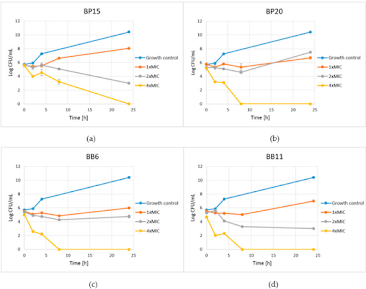Antibiotics
This study aimed at investigation of the antimicrobial potential of ethanolic extracts of bee bread (BB) and bee pollen (BP) and suspensions of these products in MHB (Mueller Hinton Broth).
We covered 30 samples of BP and 19 samples of BB harvested in Polish apiaries. Slightly lower activity was observed against Gram-negative bacteria compared to Gram-positive staphylococci. BB extracts exhibited higher inhibitory potential with minimum inhibitory concentration (MIC) values in the range from 2.5 to 10% (v/v) against Staphylococcus aureus ATCC 25923 and ATCC 29213. Most active BB extracts, namely, BB6, BB11 and BB19, effectively inhibited growth of clinical isolates of S. aureus (n = 9), including MRSA (methicillin resistant Staphylococcus aureus) strains (n = 3) at concentrations ranging from 2.5 to 5.0% (v/v).
Minimal bactericidal concentration (MBC) values were in the same range of concentrations; however, a shift from 2.5 to 5.0% (v/v) was observed for some products. The most active BP extracts inhibited the growth of reference strains of S. aureus at a concentration of 5% (v/v). Up to the concentration of 20% (v/v) three and seven BP extracts were not able to inhibit the growth of S. aureus ATCC 29213 and S. aureus ATCC 25923 respectively.
The growth of staphylococci was also importantly inhibited in suspensions of the products in MHB. No correlation between phenolic content and antimicrobial activity was observed.
We covered 30 samples of BP and 19 samples of BB harvested in Polish apiaries. Slightly lower activity was observed against Gram-negative bacteria compared to Gram-positive staphylococci. BB extracts exhibited higher inhibitory potential with minimum inhibitory concentration (MIC) values in the range from 2.5 to 10% (v/v) against Staphylococcus aureus ATCC 25923 and ATCC 29213. Most active BB extracts, namely, BB6, BB11 and BB19, effectively inhibited growth of clinical isolates of S. aureus (n = 9), including MRSA (methicillin resistant Staphylococcus aureus) strains (n = 3) at concentrations ranging from 2.5 to 5.0% (v/v).
Minimal bactericidal concentration (MBC) values were in the same range of concentrations; however, a shift from 2.5 to 5.0% (v/v) was observed for some products. The most active BP extracts inhibited the growth of reference strains of S. aureus at a concentration of 5% (v/v). Up to the concentration of 20% (v/v) three and seven BP extracts were not able to inhibit the growth of S. aureus ATCC 29213 and S. aureus ATCC 25923 respectively.
The growth of staphylococci was also importantly inhibited in suspensions of the products in MHB. No correlation between phenolic content and antimicrobial activity was observed.

No comments:
Post a Comment